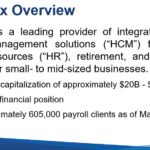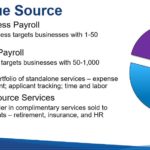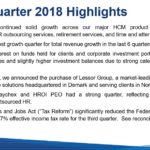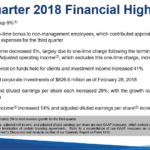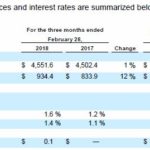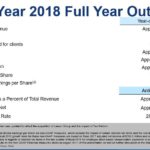Contents
 Summary
Summary
- Paychex reported strong Q3 results on March 26th and earlier in March it announced an acquisition in Germany which will offer PAYX the opportunity to expand its market penetration in Europe.
- The balance sheet is pristine and it continues to generate strong free cash flow.
- PAYX’s stock valuation has retraced from recent highs to a level where I am now willing to acquire shares to hold for the long-term.
Introduction
Paychex (NASDAQ: PAYX) released its Q3 2018 results on March 26th. I have been watching it retrace from its high (~$73) since the end of January 2018 with the hopes of being able to reacquire shares at a more reasonable valuation.
I once held PAYX shares in our daughter’s Registered Education Savings Plan (RESP) but had to liquidate the shares so as to fund her education expenses. My intent was to turn around and reacquire PAYX shares since I have always liked the company but I ended up acquiring shares in other companies.
Business Analysis
PAYX’s historical timeline can be found here.
It maintains office locations in 40 of the US states and also offers payroll services through 4 office locations in Germany; PAYX has been operating in Germany for 10 years.
Its lines of business are human resource (HR), retirement, and insurance services for small to medium sized businesses. It offers a comprehensive portfolio of integrated human capital management (HCM) services and products.
Source: PAYX Q3 2018 Highlights and Financial Results
The payroll processing services include:
- payroll processing;
- payroll tax administration services;
- employee payment services;
- regulatory compliance services (new-hire reporting and garnishment processing).
Small businesses are supported through PAYX’s proprietary softwareas-a-service (“SaaS”) Paychex Flex platform, and SurePayroll SaaS-based products.
Mid-market companies typically have more sophisticated payroll and benefits needs. They are serviced through Paychex Flex Enterprise solution set, which offers an integrated suite of HCM solutions through the Paychex Flex platform. Its SaaS solution through Paychex Flex Enterprise integrates payroll processing with HR management, employee benefits administration, time and labor management, applicant tracking, and onboarding solutions.
PAYX also offers a suite of complementary Human Resource Services (HRS) products consisting of:
- comprehensive HR outsourcing;
- retirement services administration;
- insurance services;
- HR administration services, including time and attendance, benefit enrollment, recruiting, and onboarding.
Paychex Advance LLC (“Paychex Advance”) provides a portfolio of services to the temporary staffing industry which includes the purchasing of accounts receivable as a means of providing payroll funding to these clients. The credit risk exposure is diversified amongst multiple clients and such arrangements are regularly reviewed for potential write-off. No single client is material in respect to total accounts receivable, service revenue, or results of operations.
The Paychex Insurance Agency, Inc. helps small-business owners navigate the area of insurance coverage (Group health and Individual health Insurance).
While PAYX grows organically it also grows through acquisition. In August 2017, it acquired HR Outsourcing Holdings, Inc.. This company provides human resources services to small and medium-sized businesses in more than 35 states.
Earlier this month, PAYX announced the acquisition of Lessor Group, a Denmark-based provider of payroll and human capital management (HCM) software solutions. This acquisition offers PAYX the opportunity to expand its market penetration in countries Lessor serves as well as other European countries in the future.
PAYX is also developing new technology, increasing efficiency, and is developing new business partnerships. In 2017, it announced the launch of a new biometric time clock for client companies as well as a general ledger service designed to reduce accounting errors and to provide real-time accounting integration.
In addition, it also entered a new partnership with the Latino Tax Professionals Association as the organization's preferred provider of payroll and HR services.
Impact of the Tax Cuts and Jobs Act (TCJ) on PAYX
PAYX’s Q3 effective income tax rate was 11.7% versus 34.2% for the same quarter the previous fiscal year. It recorded a one-time net tax benefit of $20.8 million for the revaluation of its net deferred tax liabilities and a net tax benefit of $36.1 million for the change in its annual effective income tax rate for the first six months of the current fiscal year which ends May 31, 2018.
These figures impacted diluted EPS by ~$0.06/share and ~$0.10/share for Q3.
Source: PAYX Q3 2018 Highlights and Financial Results
Q3 2018 Results and Forecast
PAYX’s Q 3 2018 results can be found here.
Source: PAYX Q3 2018 Highlights and Financial Results
Two of PAYX’s attractive features are that it:
- has a pristine balance sheet with virtually no long-term liabilities;
- generates strong free cash flow annually.
Source: PAYX Q3 2018 Highlights and Financial Results
Q3 sales to new businesses were up ~7% compared to Q3 2017. The small end of the market, less than 10 employees, is performing well but the mid-market, 20 - 500 employees, has become increasingly competitive. PAYX’s comprehensive HR outsourcing services which it considers to be part of the mid-market, however, has performed well in both sales and client retention.
On the March 26, 2018 conference call, management indicated that the labor market is exhibiting signs of tightening. Growth in jobs is stabilizing because of challenges in finding qualified employees. PAYX expects this will result in business owners making positive changes to wages and benefits as they compete for top talent.
Compensation-related costs increased 7% as compared to Q3 2017. This was driven by higher wages together with additional investments made in employees. Furthermore, a one-time bonus was paid to non-management employees during Q3 which contributed ~2% to total expense growth for Q3. While the magnitude of this increase is sizable I am pleased to see that management saw fit to share some of the benefits resulting from the TCJ with non-management employees and not just senior executives and shareholders.
Another positive outcome from the TCJ is that PAYX will be:
- accelerating certain technology projects for the continued evolution of the customer experience;
- increasing marketing spend;
- making sales and service strategy enhancements;
- investing in employees.
In my previous article I had indicated that PAYX faced a possible setback depending on the outcome of the Department of Labor's Overtime Rule. On August 31, 2017, a federal judge in Texas struck down an Obama-era federal overtime rule which would have made more than 4 million currently exempt employees eligible for overtime pay. If that federal overtime rule had been enacted it could have had a negative impact on the demand for Human Capital Management solutions.
The rising interest environment contributed to a 37% ($18.1 million) increase in interest on funds held for clients relative to Q3 2017. This increase was primarily due to strong calendar year-end bonus payments and wage inflation, partially offset by client mix.
Source: PAYX Q 2018 Earnings Press Release
Source: PAYX Q3 2018 Highlights and Financial Results
Free Cash Flow (FCF)
PAYX consistently generates strong FCF. FY2008 – FY2017 results for this metric for are as follows: $0.725B, $0.689B, $0.611B, $0.715B, $0.707B, $0.675B, $0.880B, $0.895B, $1.018B, and $0.960B. For the 9 months ending February 28, 2017 and 2018, FCF amounted to $0.6941B and $0.6817B.
Valuation
PAYX has forecast a ~13% - ~14% increase in diluted EPS and a ~15% - ~16% increase in adjusted diluted EPS for FY2018 relative to FY2017.
In FY2017, PAYX reported diluted EPS of $2.25 and adjusted diluted EPS of $2.20. On this basis, if we use the mid-point of both ranges reflected above we get a FY2018 projection of ~$2.55 diluted EPS (a 13.5% increase from FY2017) and a projection of ~$2.54 adjusted diluted EPS (a 15.5% increase from FY2017).
With PAYX trading at $61.22 as at the close of business on March 26, 2018, we arrive at a forward diluted PE of ~24 and a forward adjusted diluted PE of ~24.1. This is slightly below the most recent historical 5 year forward PE level of ~24.6.
The upcoming May 2018 $0.50 quarterly dividend payment will mark the 4th quarterly payment at this level. In keeping with PAYX’s historical practice of announcing a dividend increase in July for the August dividend payment, I anticipate another $0.04/quarter dividend increase will be announced in July; this is the amount PAYX has increased its quarterly dividend in the last few years.
With PAYX trading at $61.22, the current $2 annual dividend yields ~3.27%. If the quarterly dividend is increased to the extent I anticipate, this would generate a forward dividend yield of ~3.53% based on the March 26th stock price.
The $2.00 annual dividend represents a ~78% dividend payout ratio using the projected ~$2.55 diluted EPS for FY2018 and a ~78.7% dividend payout ratio using the projected ~$2.54 adjusted diluted EPS for FY2018. These ratios are high but are consistent with PAYX’s historical levels.
As I noted in previous posts, the nature of PAYX’s business and the manner in which the company is operated enables the Board to maintain a high dividend payout ratio without negatively impacting the company’s ability to grow.
During the first 9 months of FY2018, PAYX repurchased 1.6 million shares for a total of $94.1 million. In the respective prior year period, it repurchased 2.9 million shares for a total of $166.2 million. The diluted weighted-average common shares outstanding, however, has remained relatively stable at ~362 million (give or take 1 or 2 million shares) since at least FY2009.
Final Thoughts
I have always admired PAYX as it is a well run company. I like the pristine balance sheet and its ability to continually generate strong FCF.
The retracement from the January 23, 2018 high of ~$73 has now brought PAYX into a more reasonably attractive price range. I intend to acquire PAYX shares but this time I will do so in a registered account where I will not incur a 15% withholding tax on the dividend payments; I previously held PAYX shares in a RESP and was incurring a 15% haircut on all dividends.
In order to purchase PAYX, I would need to convert CDN to USD. I recognize the Canadian dollar/US dollar foreign exchange rate of ~1.28:1 is not attractive at the moment. I, however, envision some headwinds for the Canadian dollar in the coming months and suspect the Canadian dollar will weaken relative to the USD.
I wish you much success on your journey to financial freedom.
Thanks for reading!
Note: I sincerely appreciate the time you took to read this article. Please send any feedback, corrections, or questions to [email protected]
Disclaimer: I have no knowledge of your individual circumstances and am not providing individualized advice or recommendations. I encourage you not to make any investment decision without conducting your own research and due diligence. You should also consult your financial advisor about your specific situation.
Disclosure: I currently do not hold a position in PAYX but intend to initiate a position within the next 72 hours unless it suddenly spikes up during this volatile environment.
I wrote this article myself and it expresses my own opinions. I am not receiving compensation for it and have no business relationship with any company whose stock is mentioned in this article.


